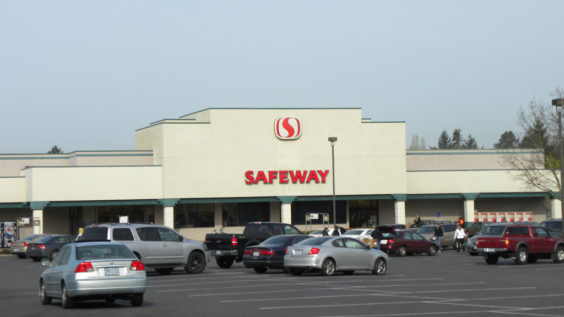
(March 6, 2014 update: Safeway announces $9 billion sale to Cerberus).
When you’re just trying to save some money and feed your family, the goings-on in the boardrooms and backrooms of those who run your local grocery store are probably of little concern. So if you skimmed over the story about Safeway in the financial pages of your local paper today, you might want to take a closer look – because it could ultimately affect where and how you shop. Especially if your preferred store is Vons, Dominick’s or a Safeway location in Arizona.
In a statement yesterday, Safeway announced that “it has adopted a one-year stockholder rights plan” after it became “aware of an accumulation of a significant amount of the common stock of the Company.” Such a move is known as a “poison pill”, designed to make a company less attractive to any outsider who might seek to gain control of it.
In other words, Safeway is afraid someone is going to swoop in, seize the company in a hostile takeover, and start making changes.
Depending on how you feel about Safeway or any of its company-owned stores, that may or may not be a good thing.
The hedge fund Jana Partners LLC revealed yesterday that it has acquired a 6.2% stake in Safeway, or more than $300 million worth, with the aim of pressuring the company to start doing things a little differently. Jana “acquired the Shares,” it explained in a regulatory filing, “because it believes the Shares are undervalued and represent an attractive investment opportunity.” Plus, it has had discussions with Safeway about possibly exiting markets where it’s not doing quite so well, in order to improve the stores and the company’s performance in the rest of its operating regions.
As other big supermarket chains like Kroger and Albertsons are expanding with new acquisitions, does the notion that Safeway is being pressured to do the opposite and slim down, mean the supermarket chain is in trouble?
Jana believes Safeway is being dragged down by its weakest links, the Wall Street Journal reports, citing “a person familiar with the firm” as saying that Safeway might do well to unload its Dominick’s chain in the Chicago area, Vons in Southern California and its Safeway locations in Arizona. If it cut those stores loose, Safeway could focus on its remaining locations where, some argue, there’s a lot of work to be done.
In fact, in a roundtable discussion published in the trade magazine Supermarket News just a day before Safeway’s “poison pill” move, a panel of grocery analysts slammed the grocery chain. “Safeway lost its opportunity to make a bigger splash with pricing over the past decade,” said Meredith Adler, managing director at Barclays Capital. “Its pricing is still too high,” agreed Scott Mushkin, managing director of Wolfe Research. “Safeway’s pricing needs to go down another 2% to 5%,” said Andrew Wolf, managing director of BB&T Capital Markets, “but time is running out.”
But what about Just for U, Safeway’s much-ballyhooed loyalty program that seeks to make shelf prices irrelevant in favor of personalized pricing? “I think Just for U is a failure so far,” Adler said bluntly. “I still don’t hear anything that good about Just for U from existing customers. Even they are saying it’s hard to use.”
Wow, so tell us how you all really feel about Safeway.
Jana Partners has been described as an “activist investor” that, Bloomberg reports, “generally invests in companies undergoing changes such as mergers, spinoffs and bankruptcies, and is known for pushing management to consider changes.”
Safeway became flush with cash after selling off its Canadian division this year for $5.68 billion. That led to some speculation, or perhaps hopeful optimism, that maybe they’d invest some of that money in better deals and lower prices. Instead, most of the money was used to pay down debt and buy back stock. “As if that really helps the business,” sniffed Adler.
So getting out of underperforming markets altogether might be the best way to help save the rest of the company. “Any money Safeway can take out of markets where it’s losing money and reinvest it in markets where it’s making money is a good thing,” Mushkin told Supermarket News. And the rest of those in that roundtable discussion weren’t ready to stop with Dominick’s, Vons and Arizona. “It would be great if Safeway could sell its Eastern division,” said Gary Giblen, managing director of GMG Capital. “Maybe H-E-B, which wants to get into Dallas, would be interested in Safeway’s Texas stores,” Wolf added.
In the end, it means a lot of uncertainty ahead for a lot of shoppers – whether you’re in Southern California, Arizona, Texas, Chicago or Washington. Safeway’s “poison pill” only lasts for a year. After that, it’s anyone’s guess what will happen.
But there’s a hitch. Safeway has tried to shop around at least some of its divisions before, to no avail. “How do you monetize something that nobody seems to want?” Adler wondered. “It’s so simple to say Safeway ought to sell. What’s harder is to come up with a buyer.”
If it does, get ready for new owners and possible changes if you shop at one of the affected stores. And if you shop at one of the stores that Safeway holds onto, get ready for potential lower prices, which these analysts and investors say Safeway so desperately needs to survive. If that turns out to be the case, maybe a hostile takeover wouldn’t be such a bad idea after all.
(March 6, 2014 update: Safeway announces $9 billion sale to Cerberus).














